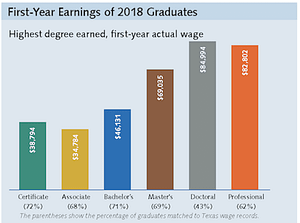Credentials of value 101: What is the minimum value threshold?
House Bill 8, this Legislature’s high-profile package of reforms aimed at overhauling community colleges’ funding formulas, tasks the state with identifying which postsecondary credentials pass the minimum value threshold (MVT) for designation as a “credential of value.” The legislation also sets the dollar amounts for rewarding colleges for graduating students with such a credential. These are not small tasks. There are over 24,000 unique credentials available in Texas including degrees, certificates, and much more.
Ultimately, it is the completion of a postsecondary credential that actually helps graduates earn a good job with higher potential wages.
In order to increase postsecondary credential attainment, the state should prioritize adopting rules that ensure HB 8’s formula funding mechanisms rewarding credential completion are meaningful enough to increase this outcome and materially lead to more graduates earning good jobs with higher wages.
There are three ways the state can achieve this:
- Review all available credentials to maximize students’ available educational options to land a good job.
- Prioritize credentials with proven job linkages so that students can assure themselves entry into occupations relevant to the credentials they earned.
- Account for different credential levels to allow students to reskill, upskill, or generally update their job market competitiveness through further education.
As the foundational step to defining credentials of value, we focus first on the credential review process.
Credential Review
Building a Talent Strong Texas: “we must award credentials that offer purpose in the economy, value in the labor market, and opportunity for a good job and meaningful career.”
The already large list of credentials in Texas will only grow as education and training providers address the ever-evolving array of skills required by employers. Community colleges are no exception. They have thousands of credentials listed in the state’s credential inventory. And state initiatives like the TRUE program are helping colleges establish additional credentials aligned with their community’s workforce needs.
The new funding formulas should support colleges’ workforce-driven investments. This is best accomplished by committing to measure all available credentials against the MVT. Failing to do so risks excluding certain pathways to employment which may be more efficient.
For instance, state data shows that non-degree credentials like certificates are delivering good wages to graduates. A particular job where we can see this is the computer user support occupation. It typically requires a relevant associate degree for entry.
However, there are new IT support certificates teaching similar skills that can be completed within six months for a low cost. If the associate degree and the certificate are determined to be credentials of value through the MVT, colleges are assured sustainable formula funding by graduating students through either program.

This broad approach to reviewing colleges’ credentials ensures state investments through HB 8 are flexible to changes in the labor market. It also encourages colleges to work with employers in jointly developing innovative programs responsive to newly-required skills.
And most importantly, students will have more available options with proven workforce value. That will allow them to choose the option best suited for wherever they are in their lives and their career path.
Read more:
- Rethinking community colleges and the workforce of the future
- Understanding HB 8: Building community colleges’ capacity
- Understanding HB 8: The new funding formulas
Love this blog? Support our work.
